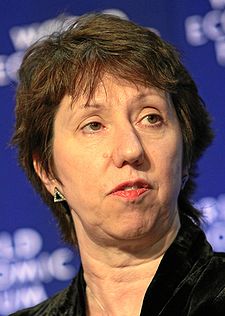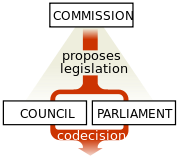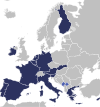Politics of the European Union
| European Union |
 This article is part of the series: |
|
Policies and issues
|
|
Foreign relations
|
The Politics of the European Union are different from other organisations and states due to the unique nature of the European Union (EU). The EU is similar to a confederation, where many policy areas are federalised into common institutions capable of making law; however the EU does not, unlike most states, control foreign policy, defence policy or direct taxation. These areas are under the control of the EU's member states although a certain amount of co-operation takes place in these areas. EU laws override national laws and policy areas are more numerous that historical confederations, however the EU is legally restricted from making law outside its remit or where it is more appropriate to do so at a national or local level (Subsidiarity).
The common institutions mix the intergovernmental and supranational (similar to federal) aspects of the EU. The EU treaties declare the EU to be based on representative democracy, and direct elections take place to the European Parliament. The Parliament, together with the Council, form the legislative arm of the EU. The Council is composed of national governments, thus representing the intergovernmental nature of the EU. Laws are proposed by the European Commission which is appointed by and accountable to the Parliament and Council although it has very few executive powers.
Although direct elections take place every five years, there are no cohesive political parties in the national sense. Instead, there are alliances of ideologically associated parties who sit and vote together in Parliament. The two largest parties are the European People's Party (centre-right) and the Party of European Socialists (centre-left) with the former forming the largest group in Parliament since 1999. As well as there being left and right dividing lines in European politics, there are also divides between those for and against European integration (Pro-Europeanism and Euroscepticism) which shapes the continually changing nature of the EU which adopts successive reforming treaties. The latter is stronger in northern Europe, especially the United Kingdom, and some member states are less integrated than others (Opt-outs).
Contents |
Legal basis
- 1. The functioning of the Union shall be founded on representative democracy.
- 2. Citizens are directly represented at Union level in the European Parliament. Member States are represented in the European Council by their Heads of State or Government and in the Council by their governments, themselves democratically accountable either to their national Parliaments, or to their citizens.
- 3. Every citizen shall have the right to participate in the democratic life of the Union. Decisions shall be taken as openly and as closely as possible to the citizen.
- 4. Political parties at European level contribute to forming European political awareness and to expressing the will of citizens of the Union..
The constitutional basis and organisation of the European Union is based on its treaties.[1] There are two principle core treaties which have been amended over its history to give the EU more competencies and reconfigure the relationship between its institutions. The treaties declare the EU to be based upon representative democracy and "on the values of respect for human dignity, freedom, democracy, equality, the rule of law and respect for human rights, including the rights of persons belonging to minorities".
The EU itself as a legal personality and a set of governing institutions empowered by the treaties. However sovereignty is not invested in those institutions, it is pooled with ultimate sovereignty resting with the national governments. Yet in those areas where the EU has been granted competencies, it does have the power to pass binding and direct laws upon its members.
Competencies
The states of the EU retain all powers not explicitly handed to the Union, as in most federations. However in some areas the EU does not have exclusive competence, it only plays a supporting role. In such middle ground member states may legislation only where the EU has not, or they may elaborate the laws of the EU. Different competencies may also be used in different ways. For example, on foreign and defence issues the Parliament has a smaller role and the Council decides by unanimity rather than by majority.
| As outlined in Part I, Title I of the consolidated Treaty on the Functioning of the European Union: | ||||||||||||||||
|
|
|
||||||||||||||
Law
Laws made by the Union supersede those made by national governments (See: Factortame case). There are three forms of binding legislative acts the Union can pass: a regulation, which is a directly applicable law; a directive, which constitutes a framework of objectives which a national law must be based on to meet the stated aims; and a decision which applies only to a particular issue.[2]
Component states
There are twenty-seven member states who have conferred powers upon the EU institutions (other countries are tied to the EU in other ways). In exchange for conffering competancies, EU states are assigned votes in the Council, seats in Parliament and a European Commissioner among other things. The internal government of member states vary between presidential systems, monarchies, federations and microstates however all members must respect the Copenhagen criteria of being democratic, respecting human rights and having a free market economy. Members joined over time, starting with the original six in 1958 and more members joining in the near future.
Some member states are outside certain areas of the EU, for example the eurozone is composed of only 16 of the 27 members and the Schengen Agreement currently includes only 21 of the EU members. However the majority of these are in the process of joining these blocs. A number of countries outside the EU are involved in certain EU activities such as the euro, Schengen, single market or defence.[3][4][5]
Institutions
The primary institutions of the European Union are the European Commission, the European Council, the Council of the European Union (Council) and the European Parliament.
The ordinary legislative procedure, applies to nearly all EU policy areas. Under the procedure, the Commission presents a proposal to Parliament and the Council. They then send amendments to the Council which can either adopt the text with those amendments or send back a "common position". That proposal may either be approved or further amendments may be tabled by the Parliament. If the Council does not approve those, then a "Conciliation Committee" is formed. The Committee is composed of the Council members plus an equal number of MEPs who seek to agree a common position. Once a position is agreed, it has to be approved by Parliament again by an absolute majority.[6][7] There are other special procedures used in sensitive areas which reduce the power of Parliament.
Parliament
The European Parliament shares the legislative and budgetary authority of the Union with the Council. Its 736 members are elected every five years by universal suffrage and sit according to political allegiance. Despite forming one of the two legislative chambers of the Union, it has weaker powers than the Council in some limited areas, and does not have legislative initiative. It does, however, have powers over the Commission which the Council does not.[8]
European Council
The European Council is the group of heads of state or government of the EU member states. It meets four times a year to define the Union's policy agenda and give impetus to integration. The President of the European Council, Herman Van Rompuy, is the person responsible for chairing and driving forward the work of the institution, which has been described as the highest political body of the European Union.[9]
Council
The Council of the European Union (informally known as the Council of Ministers or just the Council) is a body holding legislative and some limited executive powers and is thus the main decision making body of the Union. Its Presidency rotates between the states every six months. The Council is composed of twenty-seven national ministers (one per state). However the Council meets in various forms depending upon the topic. For example, if agriculture is being discussed, the Council will be composed of each national minister for agriculture. They represent their governments and are accountable to their national political systems. Votes are taken either by majority or unanimity with votes allocated according to population.[10]
Commission
The European Commission is composed of one appointee from each state, currently twenty-seven, but is designed to be independent of national interests. The body is responsible for drafting all law of the European Union and has a monopoly over legislative initiative. It also deals with the day-to-day running of the Union and has a duty to uphold the law and treaties (in this role it is known as the "Guardian of the Treaties").[11]
The Commission is led by a President who is nominated by the Council (in practice the European Council) and approved by Parliament. The remaining 26 Commissioners are nominated by member-states, in consultation with the President, and has their portfolios assigned by the President. The Council then adopts this list of nominee-Commissioners. The Council’s adoption of the Commission is not an area which requires the decision to be unanimous, their acceptance is arrived at according to the rules for qualified majority voting. The European Parliament then interviews and casts its vote upon the Commissioners. The interviews of individual nominees are conducted separately, in contrast to Parliament’s vote of approval which must be cast on the Commission as a whole without the ability to accept or reject individual Commissioners. Once approval has been obtained from the Parliament the Commissioners can take office.[12] The current President is José Manuel Barroso (EPP), his commission was elected in 2004 and is set to be reelected in 2010.[11]
Elections
Direct elections take place to the European Parliament every five years. The Council and European Council is composed of nationally elected or appointed officials and thus are accountable according to national procedures. The Commission also isn't direct elected although future appointments of the President must take into account of results of Parliament's elections.
Parliament's elections are held by universal suffrage of EU citizens according to national restrictions (such as age and criminal convictions). Proportional representation is used in all parliamentary constituencies.[13] Members of the European Parliament cannot also be elected nationally and are elected in national or sub-national constituencies. The first such election was of the in 1979. The latest elections were in 2009 The turnout has fallen in every EU election since the first. In 2009, the overall turnout was just 43%, down from 45.5% in 2004. In Britain the turnout was just 34.3%, down from 38% in 2004.
Political parties
Political parties in the member states organise themselves with like-minded parties in other states into political parties at European level or Europarties. Most national parties are a member of one of these Europarties and there are currently 11 that are recognised and receive EU funding. Europarties behave and operate to a certain extent like national parties but only the larger ones (EPP, PES, ELDR) put forward comprehensive manifestos during the campaigns for the European elections.
The Europarties are horizontally present in all the main institutions - Council, Commission, Parliament - but are most active through their political groups in Parliament. At the beginning of every parliamentary term, most organise themselves with other parties, non attached national parties or independents to form a political group. No party has ever held a majority in the Parliament, this does not have a great effect as it does not form a government but there is usual a coalition between the two major parties to elect the President of the European Parliament.[14][15][16]
| Group | Sub-parties | Leader(s) | Est. | MEPs | |
|---|---|---|---|---|---|
| European People's Party (EPP) | European People's Party (EPP) | Joseph Daul | 2009 | 265 | |
| Progressive Alliance of Socialists and Democrats (S&D) | Party of European Socialists (PES) +2 unaffiliated national parties |
Martin Schulz | 2009 | 184 | |
| Alliance of Liberals and Democrats for Europe (ALDE) | European Liberal Democrat and Reform Party (ELDR) European Democratic Party (EDP) + 3 independent politicians |
Guy Verhofstadt | 2004 | 84 | |
| The Greens–European Free Alliance (Greens–EFA) | European Green Party (EGP) European Free Alliance (EFA) + 2 unaffiliated national party + 6 independent politicians |
Daniel Cohn-Bendit Rebecca Harms |
1999 | 55 | |
| European Conservatives and Reformists (ECR) | Alliance of European Conservatives and Reformists (AECR) European Christian Political Movement (ECPM) |
Michał Kamiński | 2009 | 54 | |
| European United Left–Nordic Green Left (GUE-NGL) | Party of the European Left (PEL) Nordic Green Left Alliance (NGLA) + 9 unaffiliated national parties |
Lothar Bisky | 2009 | 35 | |
| Europe of Freedom and Democracy (EFD) | Alliance for Europe of the Nations (AEN) Libertas + 5 unaffiliated national parties |
Nigel Farage Francesco Speroni |
2009 | 31 | |
| Non-Inscrits (NI) | 11 national parties | N/A | 28 | ||
| Source for MEPs: European Parliament | Total | 736 | |||
Foreign affairs

The EU's foreign affairs are driven by its Common Foreign and Security Policy (CFSP) and also through the Commission-led economic trade negotiations. The EU's chief diplomat, sometimes dubbed its foreign minister, is the High Representative Catherine Ashton.
Foreign policy is still largely the domain of the member-states however and there has been significant disagreement between members. The failure to present a common voice on the world stage has led to the EU being sidelined in international negotiations.
Issues
The Financial Perspective for 2007–2013 was defined in 2005 when EU members agreed to fix the common budget to 1.045% of the European GDP.[17] UK Prime Minister Tony Blair agreed to review the British rebate, negotiated by Margaret Thatcher in 1984. Former French President Jacques Chirac declared this increase in the budget will permit Europe to "finance common policies" such as the Common Agricultural Policy or the Research and Technological Development Policy. France's demand to lower the VAT in catering was refused.[18] Controversial issues during budget debates include the British rebate, France's benefits from the Common Agricultural Policy, Germany and the Netherlands' large contributions to the EU budget, reform of the European Regional Development Funds, and the question of whether the European Parliament should continue to meet both in Brussels and Strasbourg.
The Treaty establishing a Constitution for Europe (TCE), commonly referred to as the European Constitution, is an international treaty intended to create a constitution for the European Union. The constitution was rejected by France and the Netherlands, where referendums were held[19] causing other countries to postpone or halt their ratification procedures. Late in 2009, a new Reform Treaty was ratified by all member states of the European Union, and took effect on 1 December 2009.
Enlargement of the Union's membership is a major political issue, with division over how far the bloc should expand. While some see it as a major policy instrument aiding the Union's development, some fear over-stretch and dilution of the Union.[20][21]
See also
- List of European Union directives
- Policies of the European Union
External links
- Official EU website: Europa
- (French) European Elections Online
- European NAvigator: The three pillars of the European Union
- Common Foreign and Security Policy (CFSP)
References
- ↑ Treaties and Law europa.eu
- ↑ "Community legal instruments". Europa (web portal). http://europa.eu/scadplus/glossary/community_legal_instruments_en.htm. Retrieved 2007-09-18.
- ↑ ECB: Introduction: Euro area ecb.int
- ↑ Schengen acquis and its integration into the Union europa.eu
- ↑ EU Battlegroups europarl.europa.eu
- ↑ "Parliament's powers and procedures". European Parliament. http://www.europarl.europa.eu/parliament/public/staticDisplay.do?language=EN&id=46. Retrieved 2007-06-12.
- ↑ "Decision-making in the European Union". Europa (web portal). http://www.europa.eu/institutions/decision-making/index_en.htm. Retrieved 2007-09-18.
- ↑ "Parliament - an overview. Welcome". European Parliament. http://www.europarl.europa.eu/parliament/public.do?language=en. Retrieved 2007-06-12.
- ↑ van Grinsven, Peter (September 2003). "The European Council under Construction" (PDF). Netherlands Institution for international Relations. http://www.nbiz.nl/publications/2003/20030900_cli_paper_dip_issue88.pdf. Retrieved 2007-08-16.
- ↑ "Institutions: The Council of the European Union". Europa (web portal). http://europa.eu/institutions/inst/council/index_en.htm. Retrieved 2007-06-25.
- ↑ 11.0 11.1 "Institutions: The European Commission". Europa (web portal). http://europa.eu/institutions/inst/comm/index_en.htm. Retrieved 2007-06-25.
- ↑ http://europa.eu/institutions/inst/comm/index_en.htm
- ↑ The European Parliament: electoral procedures europarl.europa.eu
- ↑ European Parliament euractiv.com
- ↑ Party Politics in the EU civitas.org.uk
- ↑ European Parliament and Supranational party system cambridge.org
- ↑ Financial Perspective 2007–2013PDF (236 KiB), Council of the European Union, 17 December 2005. Accessed 25 January 2007.
- ↑ "Poles block EU deal on lower VAT", Times Online, 31 January 2006. Accessed 24 January 2007.
- ↑ "Varied reasons behind Dutch 'No'", BBC News Online, 1 June 2005. Accessed 24 January 2007.
- ↑ EP Draft report on division of powers europarl.europa.eu
- ↑ Q&A: EU Enlargement news.bbc.co.uk
|
||||||||||||||||||||||||||||||||||||||||||
|
|||||||||||||||||





